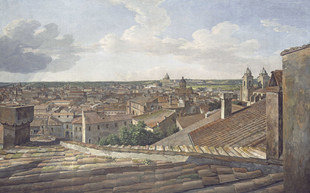Johann Christian Reinhart
dal 19/2/2013 al 25/5/2013
Segnalato da
19/2/2013
Johann Christian Reinhart
Neue Pinakothek, Munich
To Rome! In the annals of art history, Reinhart occupies a place alongside Joseph Anton Koch as the leading proponent of the heroic landscape. Reinhart's canvases splendidly document a particular moment and style in art history.

At the dawn of the 19th century, Johann Christian Reinhart (1761-1847) was revered
as one of the leading German landscape painters of his day. The Neue Pinakothek is
holding the first monographic exhibition to be dedicated to this artist, who has
since fallen into relative obscurity.
In the annals of art history, Reinhart occupies a place alongside Joseph Anton Koch
as the leading proponent of the heroic landscape. This form of classical landscape
painting was inspired by the historical precursors of the genre in the 17th century,
such as Nicolas Poussin and Gaspard Dughet. By reviving the style of the grand
landscape, populated by richly evocative staffage that included figures from
mythology and history, this 'heroic' form of landscape painting subsequently helped
elevate the status of the genre as a whole.
Regular visitors to the Neue Pinakothek will already be familiar with Reinhart's
work through the four views of Rome he painted for King Ludwig I, which together
form a magnificent panorama of the Eternal City in the years around 1830. Reinhart's
canvases splendidly document a particular moment and style in art history, but they
also form a remarkable historical document of the city at that point in time. Today,
Reinhart is primarily remembered for his etchings of Italian landscapes, and in
particular for those »prospects etched with a painter's eye« which garnered him
international fame and respect.
The exhibition, organized in collaboration with the Hamburger Kunsthalle, presents a
comprehensive overview of this exceptional artist's oeuvre and is, as such, the
first of its kind. The some 35 paintings, 40 etchings, and 90 drawings on display
stem from the most prestigious collections in the German-speaking world and beyond.
Among them are also several recently rediscovered works, which are now going on show
for the first time within the broader context of the artist's overall oeuvre.
Johann Christian Reinhart was born in 1761 to a Protestant vicar and his wife in the
small town of Hof an der Saale (Bavaria). He started reading theology in Leipzig but
soon abandoned his studies to take up art instead. He learned the basics of
landscape art under Adam Friedrich Oeser in Leipzig and Johann Christian Klengel in
Dresden. It was during this time that he created nature studies and his first
etchings. He met the poet Friedrich Schiller in Leipzig in 1785. Reinhart shared
Schiller's passionate belief in human liberty and the two remained friends until the
poet's death.
In 1789 Reinhart decided to move to Italy after receiving a grant from a patron. He
arrived in Rome in December of the same year. His new surroundings inspired a flurry
of activity, and he drew and painted numerous nature studies in the ruins of Rome
and its environs, which he explored during several prolonged tours. For Reinhart,
the Italian countryside encapsulated the ideal of landscape - a view shared by
Goethe who visited Italy just a few years before him. It became a constant theme
upon which he produced numerous variations, initially in the form of etchings, but
soon also as large-scale paintings.
While the works from his time in Rome, and in particular his paintings, can be found
in many major galleries, there remains much to be discovered in the work from his
formative years in Germany. For instance, Reinhart's stunning series of views of the
Rhine only came to light very recently - a set of pictures that rank as one of the
incunabula of realistic landscape painting in Germany.
Over the course of his long career, Reinhart created scores of drawings, paintings,
and etchings that brought him fame across the entire continent. For decades,
Reinhart was the key figure in the community of German artists living in Rome. He
was known for his joie de vivre, upright character, and a proclivity towards wit and
satire that also manifested itself in his biting caricatures. Having reached a grand
old age, he died in 1847 in Rome, his chosen home. He was honoured as a member of
the academies in Berlin, Rome, and Munich and was buried at the Protestant cemetery
near the Pyramid of Cestius.
The exhibition is accompanied by an extensive catalogue, richly illustrated
completely in colour. It is the first comprehensive overview of Reinhart's work to
be published since Inge Feuchtmayr's noteworthy catalogue raisonné of 1975, and
reflects the current standard of scholarship on the artist.
Image: Johann Christian Reinhart
View from the Villa Malta in Rome looking West to the Vatican and St. Peter’s, 1835
Tempera on canvas, 167 x 266,5 cm
© Bayerische Staatsgemäldesammlungen, Neue Pinakothek, Munich
Press contact:
Tine Nehler and Christine Kramer T +49 (0)89 23805-118/ -253 / -286. F +49 (0)89 23805-125 presse@pinakothek.de
Press preview: 20.02.2013, 11.00 a.m.
Opening: 20.02.2013, 7.00 p.m.
Neue Pinakothek
Barer Strassee 29 49, Munich
Open daily except TUES 10.00–18.00, WED 10.00–20.00
Admission: Neue Pinakothek 7 Euros | concessions: 5 Euros
Admission on Sundays: 1 Euro



